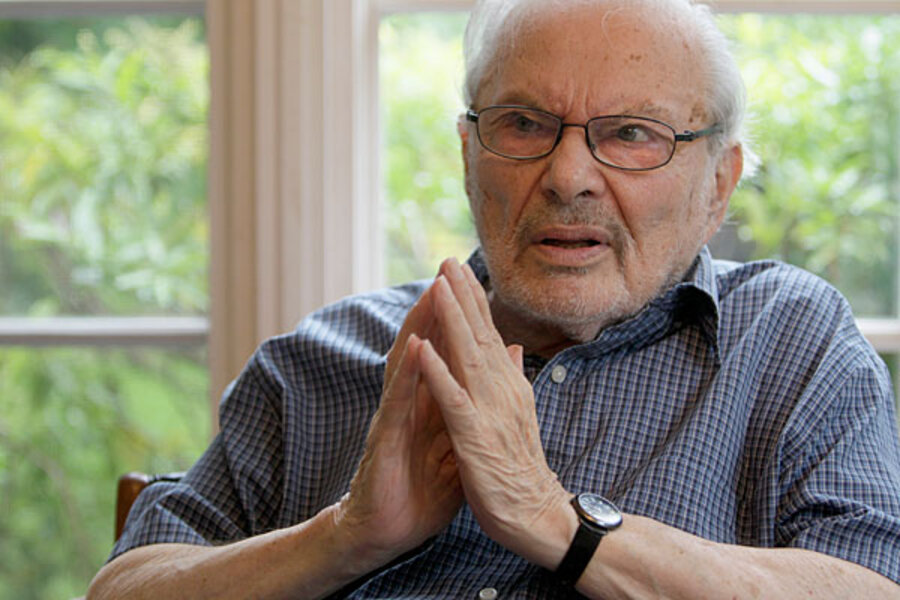'Where the Wild Things Are' author Sendak wrote to 'communicate profound truths'
Loading...
| Los Angeles
Iconic author and illustrator Maurice Sendak, who died Tuesday morning, never had children. But he understood the power of the parent-child bond, and the relationships that avid readers young and old had with his book were as intimate and passionate as any between parent and offspring.
“Maurice Sendak, for me,” says Joseph Heithaus, a DePauw University professor, poet, and father of four via email, “embodied the pleasure of curling in next to your child and reading something that could delight both of you.” His youngest, now 10, he says, “still wants her childhood story books read aloud at night, and just last week we read again ‘Chicken Soup with Rice.’ ”
That Sendak poem, he says, “even outside its hilarious illustrations, does just what a poem should do. It sets up a pattern and then surprises you again and again.”
Professor Heithaus says the Sendak work, working similarly to a ghazal, an ancient Persian poetic form, incites the reader to play along. “What child hearing that book aloud doesn't join you in the refrain – Chicken Soup with Rice?” he says.
Mr. Sendak himself always rued the fact that he did not have children of his own, however, and toward the end of his career created the Sendak Fellowship. This month-long retreat brought authors to his remote Connecticut compound for weeks of intense artistic inquiry – and genuine fellowship, say those fortunate enough to have partaken in one of the only two held.
“He wanted to pass along what he knew and felt to be important,” says award-winning children’s book author Antoinette Portis (“Not a Box”), adding, “I think he felt we were his children in a way.”
What struck her so keenly was the gap between the persona Sendak himself took a certain pleasure in cultivating – that of a gruff and crusty grouch – and the man she experienced and came to love. “He was very passionate and completely honest,” she says, “but that was because I really think he was seeking a deep relationship with his fellow artists.”
She recalls her first day, arriving at the countryside home and wondering along with the three fellows if they would see much of the esteemed author, other than the formal talks and colloquia. “But then, the first night he came and had dinner with us and just hung out with us,” she says, “and that was how it went after that.”
This closeness did not exclude blunt critiques of their work, Ms. Portis says with a laugh, recalling Sendak’s own rages against what he considered the growing commercialism of the publishing world.
“He just had this high sense of the truth these picture books should tell,” she says, and he felt that the pressure to make books to sell – rather than communicate profound truths – was ruining the world of children’s literature. “He was always telling us to go out and change the world,” she says, adding, “He felt that was the job of literature.”
Sendak rebelled against the label of “children’s author,” often saying “I don’t write children’s books. I write.”
His seminal 1963 work, “Where the Wild Things Are,” threw down that challenge to an industry for which children’s books with dark themes were frowned upon, says Susan Mackey-Kallis, associate professor of film and media studies at Villanova University in Philadelphia.
The book was criticized by parents and withheld from libraries for being “too dark,” she notes. But, it then went on to win the coveted Caldecott Medal for children’s literature in 1964 and has “become a beloved classic of children and parents who grew up with Max and his wild rumpus,” she adds.
The power of Sendak’s works stem from his own intense connection with his own early fears and fights.
The monsters in the “wild things” are modeled on Eastern European relatives who fled the Holocaust and ended up in his childhood Brooklyn neighborhood. Sendak never revealed this connection while any of these figures were still alive.
“But this visceral response to the terrors of strange people hugging him and speaking in languages he didn’t understand is something every child can relate to,” points out Professor Mackey-Kallis.
Sendak never lost this closeness to his own childhood, she adds, “and that is what gives his works so much power.”







